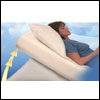Raising the head of the bed to treat orthostatic hypotension
 Orthostatic hypotension is an excessive decrease in blood pressure that occurs when a person stands up. It results in reduced blood flow to the brain and dizziness or fainting.
Orthostatic hypotension is an excessive decrease in blood pressure that occurs when a person stands up. It results in reduced blood flow to the brain and dizziness or fainting.
Researchers in Ireland studied the effects of sleeping on a bed where the head is raised 6 inches.
First, the details.
- 100 older adults with chronic orthostatic hypotension were randomly assigned to a treatment group for 6 weeks.
- Sleeping on a bed where the head is raised 6 inches
- Control group
- Changes in mean arterial pressure and symptoms were recorded, as well as a battery of other parameters.
And, the results.
- Symptoms improved to a similar extent in both groups.
- There were no differences in any of the outcomes measured.
The bottom line?
The authors concluded, “These findings suggested that sleeping-head-up at 6 inches has no additional effects on symptoms or hemodynamic parameters at 6 weeks than existing non-pharmacological measures in older patients with orthostatic hypotension.
Telling someone to sleep with their head raised 6 inches is misleading. The objective is to have a continuous 6-inch incline from the butt to the head. Simply sleeping with your head at an angle while the rest of the body is horizontal will do nothing except cause a stiff neck.
Caution, placing 6 inches of blocks under the legs at the head of the bed places lots of stress on the frame. I’ve bent a metal frame trying it.
2/20/11 21:07 JR